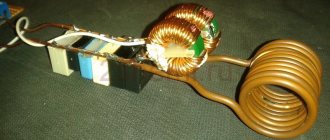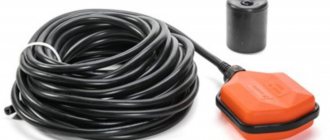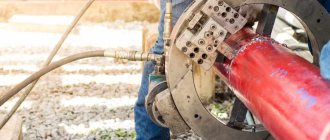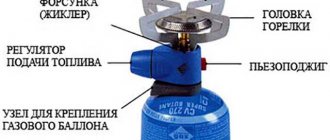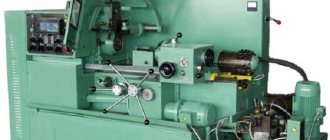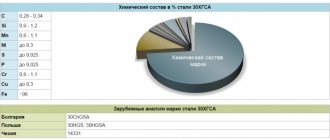The principle of heating materials by induced high-frequency currents has long been used in industry. The method can be used in everyday life to heat water, including for heating a house, since energy transfer occurs more efficiently and with fewer losses. Let's look at what an induction heater is, how it works, what pros and cons it has, and what are the features of making it yourself.
Induction type water heating unit Source by.kotel-electr.ru
Induction heating - what is it, application
Currently, the industry widely uses the method of non-contact heating of workpieces before performing various types of operations - melting, welding, soldering, forging, etc. Its efficiency is so high that it is quickly replacing traditional heating methods. Moreover, due to the peculiarities of energy transfer - without the use of a conductor - losses are minimal, and therefore the method has a high economic indicator.
Induction heating is an increase in the temperature of objects made of electrically conductive materials through the action of an alternating magnetic field in their structure. The technological essence of the procedure is as follows:
- The object that needs to be heated is placed inside an inductor - a conductor twisted in the form of a spiral.
- Next, alternating currents of high strength and different frequencies are sent to the inductor through a special generator.
- As a result, the conductor begins to emit an alternating magnetic field.
- An electrically conductive object is penetrated by this field, as a result of which induced currents arise in it.
- Under the influence of eddy currents, the temperature of the material increases.
The simplest induction heating device Source ytimg.com
This “inductor-object” circuit is essentially a transformer without a core. In it, the inductor is the primary winding, the object is the short-circuited secondary. The magnetic field flows are closed between them through the air. In powerful industrial installations, the inductor conductor itself can become very hot, so to ensure safety, a cooling system is connected to it.
The principle of induction heating is widely used in a wide variety of fields:
- Non-contact welding, melting and soldering of ultra-high purity.
- Heat treatment and bending of elements and assemblies in the automotive industry.
- Creation of experimental samples of alloys.
- Jewelry making.
- Hardening of products on the surface.
- Heat treatment of small-sized parts that are not accessible to plasma and arc.
- Heat treatment and hardening of elements of complex shapes.
- Disinfection of devices and instruments in medicine.
Instantaneous water heater is one of the most commonly used applications of induction heating in the home Source equipmaster.ru
On a note! The non-contact heating method has also found wide application in the manufacture of household heating devices, especially for water. However, in price, such models are significantly superior to traditional analogues operating on heating elements. Therefore, with sufficient experience, you can make them yourself.
Channel furnace
The channel induction melting furnace is the first one used in industry. It is structurally similar to a transformer, see fig. on right:
Channel induction furnace
- The primary winding, powered by a current of industrial (50/60 Hz) or high (400 Hz) frequency, is made of a copper tube cooled from the inside by a liquid coolant;
- Secondary short-circuited winding – melt;
- A ring-shaped crucible made of heat-resistant dielectric in which the melt is placed;
- Magnetic circuit assembled from transformer steel plates.
Channel furnaces are used for melting duralumin, non-ferrous special alloys, and producing high-quality cast iron. Industrial channel furnaces require priming with a melt, otherwise the “secondary” will not short-circuit and there will be no heating. Or arc discharges will appear between the crumbs of the charge, and the entire melt will simply explode. Therefore, before starting the furnace, a little melt is poured into the crucible, and the remelted portion is not poured completely. Metallurgists say that a channel furnace has residual capacity.
A channel furnace with a power of up to 2-3 kW can be made from an industrial frequency welding transformer yourself. In such a furnace you can melt up to 300-400 g of zinc, bronze, brass or copper. You can melt duralumin, but the casting needs to be allowed to age after cooling, from several hours to 2 weeks, depending on the composition of the alloy, so that it gains strength, toughness and elasticity.
Note: duralumin was actually invented by accident. The developers, angry that they could not alloy aluminum, abandoned another “nothing” sample in the laboratory and went on a spree out of grief. We sobered up, returned - and no one had changed color. They checked it - and it gained the strength of almost steel, while remaining as light as aluminum.
The “primary” of the transformer is left standard; it is already designed to operate in the short-circuit mode of the secondary with a welding arc. The “secondary” is removed (it can then be put back and the transformer can be used for its intended purpose), and a ring crucible is put in its place. But trying to convert an HF welding inverter into a channel furnace is dangerous! Its ferrite core will overheat and shatter into pieces due to the fact that the dielectric constant of ferrite is >>1, see above.
The problem of residual capacity in a low-power furnace disappears: a wire of the same metal, bent into a ring and with twisted ends, is placed in the seeding charge. Wire diameter – from 1 mm/kW furnace power.
But a problem arises with a ring crucible: the only material suitable for a small crucible is electroporcelain. It is impossible to process it yourself at home, but where can you get a suitable one? Other refractories are not suitable due to high dielectric losses in them or porosity and low mechanical strength. Therefore, although a channel furnace produces smelting of the highest quality, does not require electronics, and its efficiency already at a power of 1 kW exceeds 90%, they are not used by home-made people.
Operating principle of the heater
The mechanism for generating heat in household electrical appliances of this type is based on the same law on which industrial installations operate. However, the scheme of their work has its own characteristics. First of all, they concern the device. Thus, a household induction instantaneous water heater consists of the following main elements:
- An inductor is a coil of copper wire. When a current passes through it, a magnetic field is formed, under the influence of which the electrically conductive material of the heater is heated.
- A generator is a converter of stable household current into a high-frequency flow required in terms of power.
Operating principle of an induction water heater Source vinteplo.ru
See also: Catalog of companies that specialize in engineering systems (heating, water supply, sewerage and others) and related work
- The heating element is a metal pipe through which a water flow is passed to produce heating. The heater simultaneously functions as a cooler for the inductor, thereby providing it with stable operating characteristics and durability.
The generator converts the current from normal to high-frequency and supplies it to the coil. The wire winding produces a magnetic field. The tube heater located inside it heats up and transfers heat to the water flow passing through it. Due to the absence of direct contact during the transition from one type of energy to another, losses are minimal. The efficiency of such electric heaters reaches 98%.
Reference! An induction boiler works according to a similar scheme discussed above, which is an economical, efficient and durable heater for the home. Only instead of a tube, a heat exchange circuit is placed in the inductor, passing through which a special coolant is heated and distributed over all radiators of the living area.
Design and principle of operation of an induction boiler for heating Source oboiman.ru
A little theory
When designing a homemade “induction”, you need to firmly remember: the minimum power consumption does not correspond to the maximum efficiency, and vice versa. The stove will take the minimum power from the network when operating at the main resonant frequency, Pos. 1 in Fig. In this case, the blank/charge (and at lower, pre-resonant frequencies) operates as one short-circuited turn, and only one convective cell is observed in the melt.
Operating modes of crucible induction furnace
In the main resonance mode, up to 0.5 kg of steel can be melted in a 2-3 kW furnace, but heating the charge/workpiece will take up to an hour or more. Accordingly, the total electricity consumption from the network will be high, and the overall efficiency will be low. At pre-resonant frequencies it is even lower.
As a result, induction furnaces for melting metal most often operate at the 2nd, 3rd, and other higher harmonics (Pos. 2 in the figure). The power required for heating/melting increases in this case; for the same half a kilo of steel, the 2nd one will need 7-8 kW, and the 3rd one 10-12 kW. But warming up occurs very quickly, in minutes or fractions of minutes. Therefore, the efficiency is high: the stove does not have time to “eat” much before the melt can be poured.
Furnaces using harmonics have the most important, even unique advantage: several convective cells appear in the melt, instantly and thoroughly mixing it. Therefore, it is possible to conduct melting in the so-called mode. rapid charge, producing alloys that are fundamentally impossible to smelt in any other melting furnaces.
If you “raise” the frequency 5-6 or more times higher than the main one, then the efficiency drops somewhat (not much), but another remarkable property of harmonic induction appears: surface heating due to the skin effect, displacing EMF to the surface of the workpiece, Pos. 3 in Fig. This mode is rarely used for melting, but for heating workpieces for surface cementation and hardening it is a nice thing. Modern technology would be simply impossible without this method of heat treatment.
About levitation in an inductor
Now let’s do a trick: wind the first 1-3 turns of the inductor, then bend the tube/bus 180 degrees, and wind the rest of the winding in the opposite direction (Pos. 4 in the figure). Connect it to the generator, insert a crucible in the charge into the inductor, and give current. Let's wait until it melts and remove the crucible. The melt in the inductor will gather into a sphere, which will remain hanging there until we turn off the generator. Then it will fall down.
The effect of electromagnetic levitation of the melt is used to purify metals by zone melting, to obtain high-precision metal balls and microspheres, etc. But for a proper result, melting must be carried out in a high vacuum, so here levitation in the inductor is mentioned only for information.
Advantages and disadvantages
The advantages of a household water heater of this type are as follows:
- Long service life. The average warranty period for most manufacturers is 30 years. At the same time, the installation does not require serious maintenance and repair with the replacement of main elements throughout the entire period of operation. Preventative cleaning is carried out no more than once every 7-9 years.
- Economical energy consumption. To produce the same amount of heat, in comparison with varieties operating on traditional heating elements, 30-40% less energy is spent.
- No scale. The specific mechanism of operation of the device eliminates the formation of scale on the working elements of the installation. In addition, when the device is turned on, it vibrates slightly, which is also a good protective factor against the build-up of various types of deposits on its internal parts in contact with water.
- Minimal risk of leaks. Non-contact heating technology eliminates the factors of destruction - when metal elements quickly rust under the influence of heat and dampness.
An induction water heater is reliable, durable and economical Source rusolymp.ru
Features of self-production
In order to make an induction heater, you must have experience in electrical work and assembling homemade electrical appliances, as well as skills in processing metal and other materials and be able to install wiring. Therefore, in their absence, it is better to entrust such work to professionals. In this case, the general algorithm for manufacturing the device consists of the following sequential stages:
- Making a heater. As a rule, a section of thick-walled metal pipe with adapters at the ends is used, enclosed in a heat-resistant plastic tube of a larger diameter.
Video description
Video example of making an induction heater:
- Creation of an inductor. An insulated copper wire with a cross-section of about 1-1.5 mm2 is tightly wound around the tube. The number of turns must be at least 90.
- Selecting a suitable alternator. The simplest and most affordable way is to use an inverter from an appropriate welding unit.
- Connecting the heater with the inductor to the water supply or heating pipe.
- Connecting the inductor to the network. The contact wires from the coil are connected to the positive contacts of the inverter.
- Power supply. Rectifier diodes are installed at the terminals. Without them, the voltage of the supplied current will be supplied rectified, and the coil will function as an electromagnet rather than an inductor.
- Turning on and checking the operation of the device.
Note! A self-made heater, unlike factory-made analogues, is not equipped with a protection and control system. Therefore, before turning it on, you must make sure that the heating element is filled with water.
Induction boiler for heating a house - comparison with a boiler using heating elements
May 16, 2012 Electric heating of the house
Greetings, reader of my site!
The topic of heating a house using electric boilers is very close to me, which I have repeatedly told you about, both on the basis of homemade electric boilers , made with my own hands , and factory-made boilers, for example, a very high-quality electric boiler Proterm , manufactured in Slovakia.
And recently, purely by chance, I came across on the Internet the use of the properties of electromagnetic induction in a household electric boiler.
This has been used in production for a long time - for example, metal is melted in induction furnaces. But the application in everyday life is interesting.
I was very interested in this information. We are talking about an induction electric boiler where an inductance coil is used as a heating element.
By the way, a similar device is used in modern induction household electric stoves, you can read more in Wikipedia
Of course, I immediately started digging for information on the Internet, what kind of induction heater is this, what is the principle of its operation, do they have an advantage over electric boilers using heating elements?
It turned out that everything was not as simple and rosy as it seemed...
Briefly about the main thing
Induction heating is based on the ability of an alternating magnetic field to increase the temperature of objects made of electrically conductive materials. Heating is carried out in a non-contact manner and is characterized by high performance and low energy losses. For this reason, the method is widely used in various fields - melting, welding, soldering of metals, heat treatment of components and elements in production, disinfection of instruments in medicine.
The same principle applies to the operation of a domestic water heater. The heating element through which the water passes is placed in an inductor coil. When a high-frequency current is applied, an alternating magnetic field is generated, heating the metal heater. Among the main advantages of such devices are:
- Durability.
- Economy.
- No scale.
- Leak-free operation.
- Natural convection.
Disadvantages are associated with the release of heat into the surrounding space, the need for a stable power supply, constant monitoring of performance characteristics, operating noise and harmful radiation. When manufacturing the device, you must follow the instructions and have sufficient experience.

